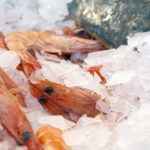Ice is ice is ice, right? Wrong. Here’s the low down on SCALE ICE from Hubbard, the ice experts.
 Scale ice is the coldest type of ice, because it is very dry, having just 2% residual water content. Many scale ice machines use salt water, which is one of several reasons scale ice is not appropriate for popping into your average G&T or Scotch on the rocks. Scale ice is used in industrial situations, for example, in the fishing industry. It’s even used on trawlers in the high seas, to store fish catches. Marine grade scale ice machines need to be tough enough to survive extreme conditions – which calls for a Scotsman!
Scale ice is the coldest type of ice, because it is very dry, having just 2% residual water content. Many scale ice machines use salt water, which is one of several reasons scale ice is not appropriate for popping into your average G&T or Scotch on the rocks. Scale ice is used in industrial situations, for example, in the fishing industry. It’s even used on trawlers in the high seas, to store fish catches. Marine grade scale ice machines need to be tough enough to survive extreme conditions – which calls for a Scotsman!
Scale ice is made up of irregular fragments of ice with a variable thickness that can be adjusted between 1 and 2mm. Other uses include fish and sea-food display, transport of perishable goods such as vegetables, and dough temperature control. Because it moulds to any shape and melts at a slow, regular rate it’s ideal for keeping food at maximum freshness.
Scotsman scale ice machines use either a horizontal or a vertical evaporating drum to make the ice. There’s a choice of integral or split models, the latter being designed to be attached to a remote or central condensing unit. Production rates vary from 426 up to 5,000kg a day.
Want to learn more? Check out Hubbard Systems’ Guide to Ice in the downloads area at scotsman-ice.co.uk
Scale ice is one of eight different ice types produced by Scotsman ice machines, each of which has a distinct application. They are gourmet ice cubes, aka supercubes, dice ice cubes, superdice ice cubes, flake ice, superflake ice, cubelet ice, nugget ice, and scale ice. They are all covered in Hubbard’s Guide to Ice.

